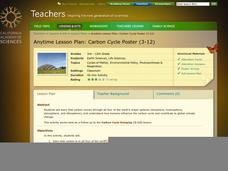Curated OER
How Do You Light Up Your World?
A tremendous presentation on the properties of light. Young scientists are treated to slides which share a lot of fascinating information about light. This impressive PowerPoint is filled with great photos, graphics, and discussion...
Curated OER
Nouveau Réalisme
Art is a form of expression that can be controversial, obtuse, and completely driven by the political and social times. Explore Nouveau Realism and Pop Art, which exemplify the nature of modern thought and expression. This visually rich...
Curated OER
The Cold War Era (1945 - 1991)
Provide learners with an excellent resource focused on the Cold War Era. Starting in 1945 and going all the way to 1991, the Cold War Era included major historical events, such as the Berlin Wall, Warsaw Pact, the Korean War, and the...
Curated OER
Try a Drawing Drawer
Integrating art into your classroom every day just got easier. This fantastic idea provides 43 strips intended to keep early finishers busy and to bring art into the classroom. You cut the strips, put them in a drawer, and have early...
Curated OER
Adding Mixed Numbers - Unequal Denominators
Working with fractions that have unequal denominators is one of the most difficult concepts for young mathematicians to master. Here you will find a fine lesson that should help youngsters begin to get a grasp on this important...
Curated OER
Subtracting Fractions - Unequal Denominators
Subtracting fractions that have unequal denominators is a tricky process. The lesson plan utilizes fraction bars as a manipulative, in order to understand subtracting fractions and estimating differences. After completing three...
Curated OER
Clothing
Review clothing vocabulary and the translation skills of your Spanish language learners. For each of 32 questions, they read the Spanish sentence and identify its correct English translation in a list of possibilities. Great practice! If...
Teach Engineering
Solar Water: Heat it Up!
Young engineers are instructed to design and build their own solar water heaters. Then, they calculate the efficiency and cost and compare them to commercially available models. This is a full unit for pupils to apply their knowledge.
Teach Engineering
The Grid
Upper graders form a "Presidential Task Force," and attempt to make recommendations concerning the future of the national power grid. After a teacher-led discussion which proves that our nation's energy consumption will soon outpace our...
Curated OER
Neural Networks and the Common Core
Why the new Common Core Standards will lead to better teaching and learning.
California Academy of Science
Fish Prints
What do a dead fish, conservation, and paint have in common? The answer is a great lesson plan about fish anatomy, fun print making techniques, and unsustainable fishing practices. The class will start by making fish prints with a...
California Academy of Science
Carbon Cycle Poster
Humans can have a big impact on the environment, specifically the influence they have on the carbon cycle. First, the class will define and discuss each of the earths four major spheres, the biosphere, hydrosphere, atmosphere, and...
Curated OER
Talk Common Core with Your Class
Familiarize your elementary, middle, or high school learners with Common Core language to increase their success.
American Chemical Society
Using the Combining Test to Identify Unknown Liquids
Once investigators have learned how their mystery liquids interact with water during the preceding activity, they now use their observations to identify them. This is an ideal conclusion to the mini unit on the properties of water.
iCivics
The “Supreme” in Supreme Court
Does a public school have the right to restrict what t-shirts learners wear? Discover what happened when this question was brought to the Supreme Court, and review other major cases in United States history involving judicial review....
American Chemical Society
Comparing the Amount of Acid in Different Solutions
Upcoming chemists use chemical reactions to determine relative pH in two different acids. This is a terrific lesson plan for middle schoolers that can stand alone as a practice in precision and lab skills, or as part of the unit on...
Exploratorium
The Three Little Pig(ments)
Photocopy single-color images onto acetate transparencies and either demonstrate or have your class experience the combination of colors to produce images. Children will learn that cyan, magenta, yellow, and black combine to make all of...
Exploratorium
Disappearing Act
Crafty critters are camouflaged to escape predators, and crafty science pupils can construct a camouflage demonstration. They work with a partner to show that as a camouflaged animal moves, it becomes more visible.
Captain Planet Foundation
Solar Cooking Race
Study heat transfer with activities that focus on how heat energy works. Using a solar cooker, ice cubes, and heat transfer bracelets, kids experiment and record what they find by keeping ice cubes cold and vegetables hot.
National Security Agency
Introducing Integers and Their Operations
There's nothing negative about this mini-unit on integers! Engaging young mathematicians in a series of hands-on activities and collaborative learning opportunities, this resource offers an excellent way to introduce your class to...
Teacher's Corner
Tanka
The Tanka, another fix from of Japanese poetry, is featured in the final exercise in a 10-part series of poetry writing activities.
Manitoba Education and Early Childhood Learning
A Foundation for Implementation
Color is the focus of this amazing resource packed with math, social studies, science, and language arts activities. Kids create a color word wall and post symbols, graph the number of objects they find of each color while on a treasure...
Curated OER
Book Nook
A reading of Dr. Seuss's My Many Colored Days provides a great intro for a discussion of colors and how they can represent emotions and moods. Kids share the feelings they associate with various colors
Shasta County Office of Education
Human Graphing Activity
Take graphing outside and make a giant coordinate plane to plot your human points. Young graphers are each given a coordinate for a particular shape and asked to make the geometrical shapes one by one. Those not plotted are to write down...

























